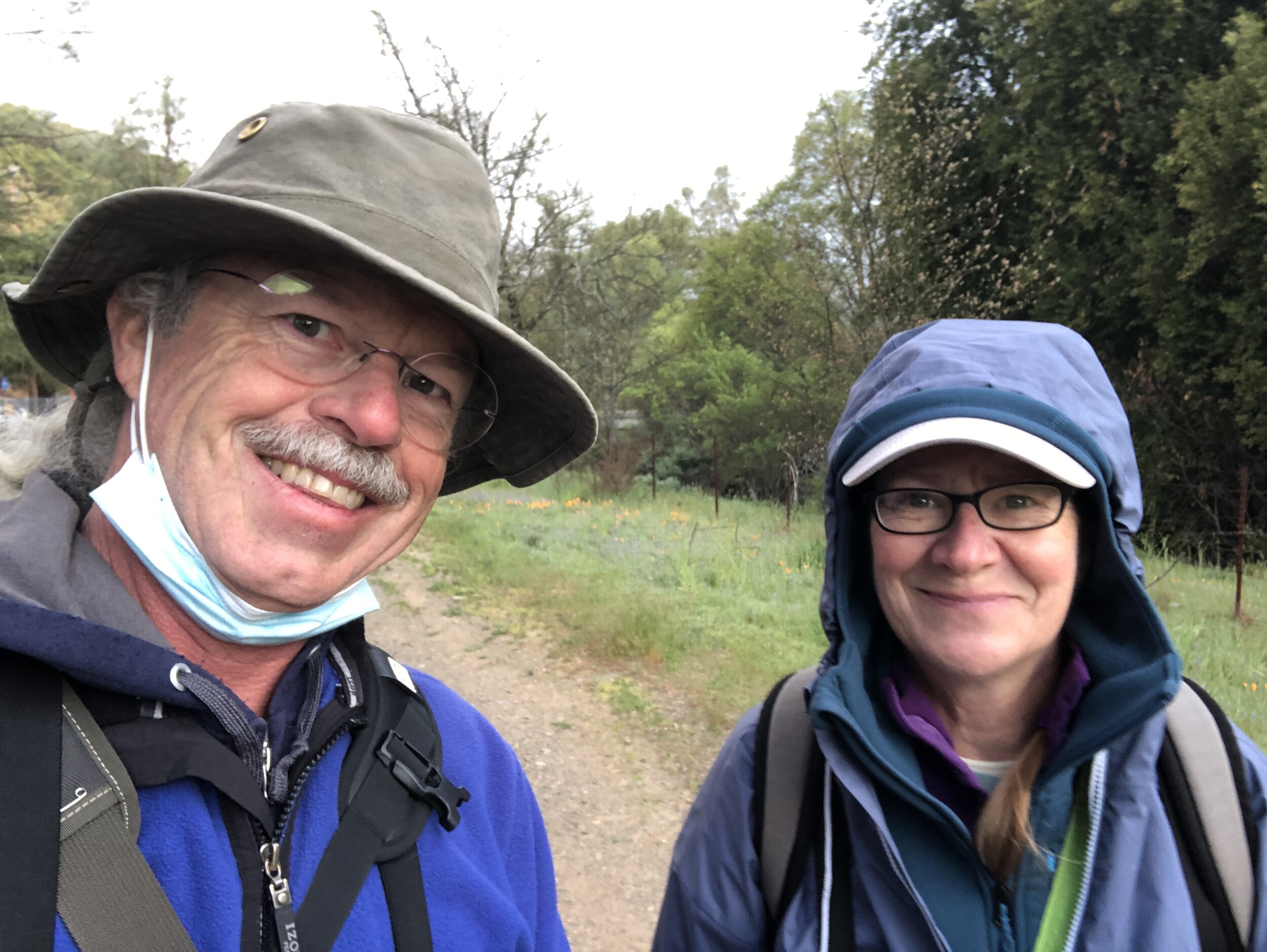The Piratical Flycatchers Big Day
Earth Day, Thursday, 22 April 2021
Shooting Stars at Smith Creek
The intricate beauty of flowers evolved to attract flying insects, offering food in exchange for pollination. The flycatchers evolved to take advantage of the abundance of insects causing the insects to evolve to avoid the flycatchers. It's way more nuanced than that, of course, but my point is that outdoors at dawn, the blanket of fog having just retreated from Smith Creek Fire Station, it's not all about birds. It's actually never all about birds, and although birds is why we're here today, layering up and donning binoculars and cameras and sound equipment and heading out on an empty trail, we also appreciate the flowers, the insects, the trees, and the beauty of the world all around us.
The summit of Mount Hamilton as seen from Smith Creek
California Poppies and Lupine along the Smith Creek Trail
Ginger and I (The Piratical Flycatchers) completed our Birdathon Big Day today. We started at 5:20am and drove halfway up Mount Hamilton to Joseph D. Grant County Park. Our timing and starting location worked out pretty well. Smith Creek was just above the marine cloud layer when we arrived so while all the world below was in fog, we and the birds were being woken up by the first warming rays of sunlight. A pair of Northern Rough-winged Swallows, whose nest was clearly somewhere nearby, circled above the gravel parking spot and alighted on the telephone wires as we started our dawn-to-dusk adventure: the first bird on our checklist.
Northern Rough-winged Swallow, Smith Creek at Mount Hamilton Road
Heading back toward the fire station at Smith Creek
Smith Creek also had Wilson’s Warblers, Orange-crowned Warblers, Warbling Vireos, Cassin’s Vireos, Hutton’s Vireos, Black-headed Grosbeaks, a Black-throated Gray Warbler and lots of other birds calling and flashing their colors, but my favorite this morning was a flock of Lawrence’s Goldfinches moving from tree to tree near the firehouse. We couldn’t get a clear count. There were at least nine birds, but possibly as many as twenty. We never found the rare Hammond’s Flycatcher that had been reported in that area (although we lost several precious minutes searching), but we didn't mind. This secluded riparian trail was just what we needed to energize us for the day.
Lawrence’s Goldfinch, Smith Creek Fire Station
From there we birded our way down the mountain with a brief stop at Twin Gates where we got our first-of-spring Bullock’s Oriole. Both Smith Creek and Twin Gates had at least one large flock of Pine Siskins (20-30 or more).
At Grant Lake we added Cliff Swallow and Caspian Tern to our year list. A White-tailed Kite circled over us with a small rodent in its talons and flew off to a distant tree where we suspect it’s feeding its young. The farm house area had Blue-gray Gnatcatcher, Lark Sparrow, Western Kingbird, Hermit Thrush and another 20+ Pine Siskins.
White-tailed Kite grasping a rodent, Grant Lake
Ginger recording the White-tailed Kite calling in flight, Grant Lake
Western Kingbird near the Grant Ranch farmhouse
Ginger at Washburn Trail at Joseph D. Grant County Park
We stopped at the Washburn Trailhead on our way out of Grant Ranch so Ginger could get some good audio of some of the birds. So many trails to take, but we held back, knowing that the birds here would largely be the same as those we'd already observed. We needed to hit as many varied habitats as we could, because different species prefer different locales and the goal was to get as many species as possible this day.
Ed Levin Park had Great-tailed Grackles, a pair of Peregrine Falcons, more Western Kingbirds, Grasshopper Sparrow and Rufous-crowned Sparrow, but no selasphorus hummingbirds that we could hear. We watched in awe as a Black Phoebe (my favorite bird!) caught and devoured a large moth.
Black Phoebe captures a moth at Ed Levin County Park
Barry at Ed Levin County Park on Tularcitos Trail above Sandy Wool Lake
Ground Squirrel…in a tree?
Down at the Baylands, the often-locked gate was actually open on the road into the Alviso Environmental Education Center, so we drove all the way in, making it a short walk to the trail overlooking Pond A16 and Mallard Slough. Tide was pretty low. We had another Peregrine Falcon and a pair of high-flying Caspian Terns.
Greater Yellowlegs with a muddy foot, Mallard Slough
Next was a quick stop at the Alviso Marina where we got a Whimbrel near the boat launch, and we puzzled over a duck for a while trying to determine whether it was a Canvasback or a Redhead (it was a Canvasback). A Forster’s Tern flew past, our first of the year.
Forster’s Tern at Alviso Marina boat launch
We stopped at the Kite Flying area on our way to Shoreline Lake. At Shoreline we did not see the Brant, but were delighted to see 14 Black Skimmers on the island and flying around. We kept hiking and when we scanned Pond A1 we were surprised to find the Brant there, mixed with a flock of Scaup. As we headed back to our car, the Brant came back to its familiar lawn spot. Pond A1 had about five Canvasback.
Black Skimmer over Pond A1
Also around the Baylands we got Barn Owl and Burrowing Owl, our only owls for the day.
It was getting late in the day at this point so we abandoned our plans to drive all the way to south county. We decided to see what else we could get in the Baylands, so we drove to the Emily Renzel Wetlands and found a Green Heron, Snowy Egret, Great Egret and Black-crowned Night-Heron all hanging out together by the pipes that run water from the north pond to the south pond. I was able to get all four in a single photo! We had many Common Gallinule and heard one Sora here as well.
The Ponds at Emily Renzel Wetlands. Snowy Egret (far left), Green Heron (up), Great Egret (down), Black-crowned Night-Heron (far right)
At Palo Alto Baylands we got our one and only American White Pelican. While looking at five Greater Yellowlegs in the mudflats, a pair of yellowlegs: one Greater and the other Lesser, flew overhead with the Lesser Yellowlegs calling it’s “too-too” call. The tide was coming in, so we went to the end of the road and watched the shorebird spectacle as the waters rose. We found two dozen Dunlin, two Semipalmated Plover, several Whimbrel (no Curlews or Godwits though), a few Willets amid thousands of peeps. Oh, and a Ridgway’s Rail wandered along the far shore, letting me photograph it in the sunlight.
Ridgway’s Rail at the Palo Alto Baylands boat launch
At Byxbee Park we found our hoped-for flock of Bonaparte’s Gulls, their heads full black and flying like butterflies above the water treatment plant. They headed out over the wetlands toward the bay and we headed inland to see if we could get a couple more birds.
We stopped at the Bubb Road Percolation Ponds and did not find anything new. As the light faded, small bats came out and flew around our heads. We then parked near Blackberry Farm and spent our last half hour listening for owls, but there were none calling.
In all we got a total of 134 species for the day — one bird shy of our best year ever (2019)! Nineteen of the birds were new for the year in the county for us. We ended our birding at 8:30pm, 15 hours of birding. *whew*
Here are the 16 eBird checklists we created to document our day, with many additional photos and some audio clips of birdsong:
https://ebird.org/checklist/S86113787— Smith Creek Fire Station
https://ebird.org/checklist/S86113837— Twin Gates
https://ebird.org/checklist/S86113906— Grant Lake
https://ebird.org/checklist/S86113973— Ranch house area
https://ebird.org/checklist/S86114012— Washburn Trailhead
https://ebird.org/checklist/S86114179— Ed Levin County Park
https://ebird.org/checklist/S86114234— Hall Memorial Park
https://ebird.org/checklist/S86132743— Don Edwards, Mallard Slough
https://ebird.org/checklist/S86132784— Alviso Marina
https://ebird.org/checklist/S86132805— Shoreline Park Kite Flying Area
https://ebird.org/checklist/S86132825— Shoreline Lake
https://ebird.org/checklist/S86132849— Salt Pond A1
https://ebird.org/checklist/S86132864— Emily Renzel Wetlands
https://ebird.org/checklist/S86132888— Palo Alto Baylands
https://ebird.org/checklist/S86132906— Byxbee Park
https://ebird.org/checklist/S86133213— a "catchall" checklist because some of the birds we saw only from the car as we traveled from one hotspot to another
Thanks to all of you who sponsored our team this year!
Barry & Ginger
The Piratical Flycatchers
~




















